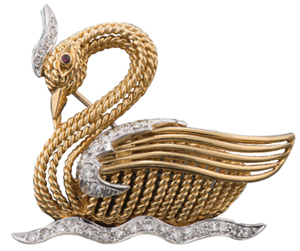|
Legacy
Nature’s Inspiration
From the luminous loveliness of an orchid to the slinky crawl of a caterpillar, nature has been the inspiration for jewelry designs from earliest times.
By Phyllis Schiller
 |
| Diamond, gemstone and gold Swan Brooch by William Ruser, circa 1950s. Private Collection. Photo courtesy Shelburne Museum. |
A source of infinitely changing wonders, nature has long been a subject of fascination for artists. In the hands of master jewelers and craftsmen, everything from a single vine leaf to an eight-foot-long python can be translated into wearable art. A new exhibition in Vermont’s Shelburne Museum explores this theme. “Natural Beauties: Jewelry From Art Nouveau to Now,” on display until March 8, 2015, showcases 284 examples of both historical jewelry created by renowned designers such as René Lalique, Tiffany & Co., and Van Cleef & Arpels and modern-day works by contemporary studio artists.
“It’s such a rich field, we thought we had to put bracket dates on it because nature has been the inspiration for jewelry from the very inception of jewelry. So we decided on the Art Nouveau period up to the modern day,” explains the museum’s Curator of Design Arts Kory Rogers, who co-curated the exhibition with Jean M. Burks, curator emerita.
Divided into sections on gems, flora and fauna, all the pieces have something to do with nature, “whether it was natural, untreated stones — or even dinosaur bones or meteorites — or pieces that were fashioned to look like flora or fauna,” explains Rogers.
Proving the timelessness of nature as a muse for jewelry creations, each category is a mix of classical and contemporary pieces. One of the stars of the show is a diamond, enamel and amethyst 18-karat gold openwork pendant created by Lalique for the actress Sarah Bernhardt. It depicts a scene from a play in which she starred. It is on display with the actual manuscript for the play in a jeweled leather case adorned with a diamond and citrine lily. An equally impressive Tiffany & Co. ivy necklace designed by Paulding Farnham can be converted into a tiara. Also in the show is a contemporary wedding/engagement ring by Bruce Baker with a leaf vine motif. “It’s made out of gold and set with a 4-carat diamond — big and impressive,” says Rogers.
Louis Comfort Tiffany enamel and semiprecious stone pieces include a large amethyst cabochon brooch with vegetation growing around its side, paired with a beautiful vine necklace made up of small enamel pieces with a big citrine in the center surrounded by pearls. Also on view are the incredibly realistic flowers modern-day master of enameling David C. Freda creates for Tiffany & Co.
In the Fauna section of the exhibit, examples range from David Webb’s amazing animals to William Ruser’s diamond-crowned Swan Brooch (shown opposite). The latter was a gift to the museum’s founder, Electra Havemeyer Webb, by her son. It references her favorite swan tureens, rare examples by the Chelsea Porcelain Factory, which she donated to the museum. Another of Ruser’s animals, a hummingbird with great pearl wings, is also in the show.
Proving that the most unlikely of animals can become spectacular jewelry, a little bitty Victorian diamond mouse brooch with an en tremblant tail has stylish stature. The slightest of movements activates the tail, allowing it to catch the light — and attention. Another moving example is a diamond and gemstone lizard by Tiffany & Co. Its articulated limbs work with gravity to position itself naturalistically on the wearer. Ted Muehling’s spider brooches have bodies of chocolate diamonds or moonstone and legs made out of gold. “If you squeeze the legs together and put the brooch on your sweater, the legs cling to the fabric so no pin is necessary to keep it in place,” explains Rogers. Muehling is also represented by his Pussy Willow Bracelet that shows off a caterpillar accented with cat’s-eye chrysoberyl, coral and yellow diamonds.
David Bielander, a Dutch artist, brings a snake to fashionable life with his eight-foot-long titanium and silver python. It coils around the wearer’s neck like a real python would. “He spent five years learning how to make the hinge so it moves naturalistically,” Rogers notes. “And although it’s eight feet long, it weighs about as much as an empty beer can.”
A more conceptual example is a baroque-looking “chandelier” necklace by German designer Constanze Schreiber. It is made out of broadtail, which, Rogers explains, “is the wool of fetal lambs. Inside the wool, the artist has put lead that approximates the weight of that fetal lamb so that every time you wear the jewel, you have the weight of the animal on your chest as a reminder of the fact that this piece was once a living organism.”
Fittingly titled “The Crown of Nature’s Bounty” is Anthony Sonnenberg’s unique tiara. Fashioned out of hammered brass, it depicts four narcotic plants — cannabis, coca, tobacco and poppy — showing that even the dark side of nature can be inherently beautiful.
“It’s important to remember that nature can take many forms and that it’s precious,” sums up Rogers. “And artists are conveying this through their work with precious material, sometimes quite literal and sometimes abstract. I hope as visitors look at the detail of these pieces, it will encourage them as they are out in nature to look at things and scrutinize them more closely.” Article from the Rapaport Magazine - February 2015. To subscribe click here.
|
|